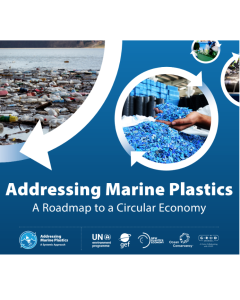
This document provides an action-oriented strategy by identifying a core set of priority solutions to be implemented by targeted stakeholders from the whole plastics value chain. It aims to reduce the leakage of plastics into the marine environment as well as its associated impacts and improve the circularity of the plastics value chain. The recommendations proposed in the Roadmap aim to reduce the adverse environmental, ecological, and socio-economic impacts from marine plastics, while transforming the linear “take-make-dispose” economy into a circular economy. Together, these actions support the 2030 Agenda for Sustainable Development, particularly SDG 12 on Responsible Consumption and Production and SDG Target 14.1, which aims to significantly reduce marine pollution, including marine debris, by 2025.
The roadmap highlights the actions in specific life cycle stages, as well as the cross-cutting solutions to link upstream and downstream stakeholders of the value chain to avoid actions done in isolation. It incorporates key upstream interventions, including designing products for maximum durability and reusing products which can contribute to reducing plastic waste generation. It integrates downstream actions that address waste streams generated by the current business-as-usual linear economy. Actions are listed and described in detail at the end of the report.
The roadmap identifies four building blocks to achieve a circular economy for plastics, including:
- Create cross-cutting enabling conditions, including institutions in terms of legal arrangements and policy, research and knowledge, stakeholder engagement and dialogue, financing, and capacity development.
- Eliminate all problematic and unnecessary plastic products, including toxic additives;
- Innovate design, production, and business models to ensure that the plastics that are needed are reusable, recyclable, or compostable and free of toxic additives;
- Circulate all plastic products at their highest value within the economy to keep them out of the environment.
